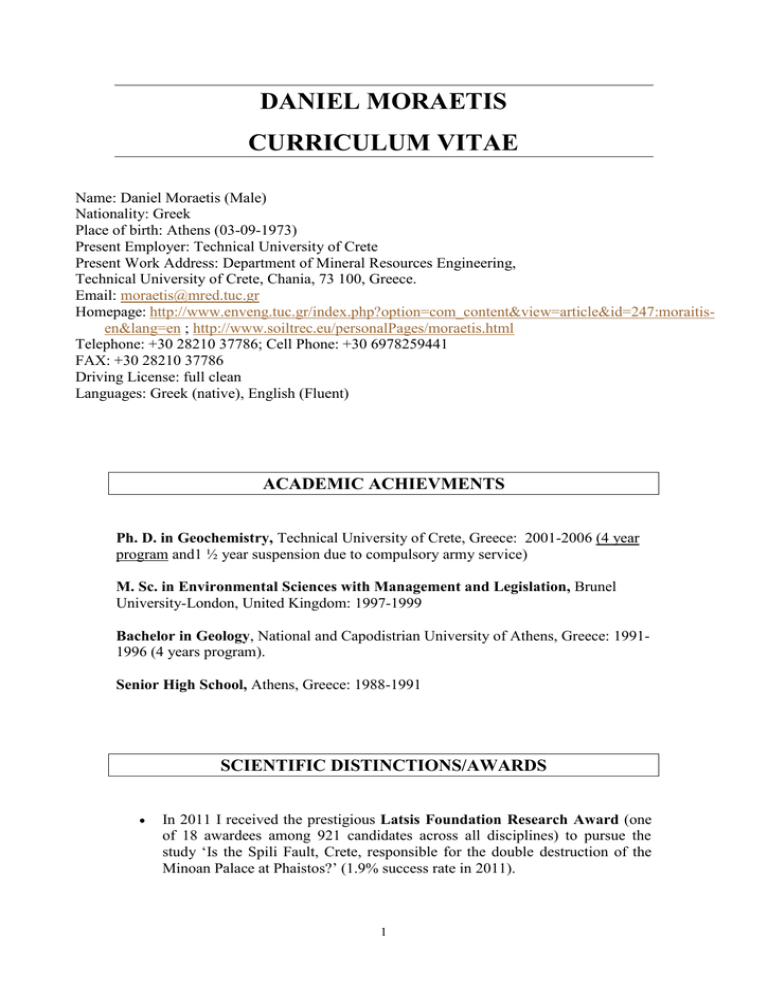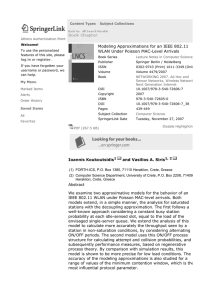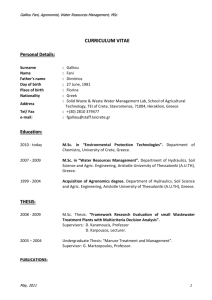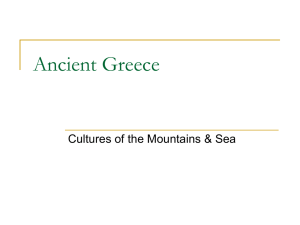DANIEL MORAETIS CURRICULUM VITAE
advertisement

DANIEL MORAETIS CURRICULUM VITAE Name: Daniel Moraetis (Male) Nationality: Greek Place of birth: Athens (03-09-1973) Present Employer: Technical University of Crete Present Work Address: Department of Mineral Resources Engineering, Technical University of Crete, Chania, 73 100, Greece. Email: moraetis@mred.tuc.gr Homepage: http://www.enveng.tuc.gr/index.php?option=com_content&view=article&id=247:moraitisen&lang=en ; http://www.soiltrec.eu/personalPages/moraetis.html Telephone: +30 28210 37786; Cell Phone: +30 6978259441 FAX: +30 28210 37786 Driving License: full clean Languages: Greek (native), English (Fluent) ACADEMIC ACHIEVMENTS Ph. D. in Geochemistry, Technical University of Crete, Greece: 2001-2006 (4 year program and1 ½ year suspension due to compulsory army service) M. Sc. in Environmental Sciences with Management and Legislation, Brunel University-London, United Kingdom: 1997-1999 Bachelor in Geology, National and Capodistrian University of Athens, Greece: 19911996 (4 years program). Senior High School, Athens, Greece: 1988-1991 SCIENTIFIC DISTINCTIONS/AWARDS In 2011 I received the prestigious Latsis Foundation Research Award (one of 18 awardees among 921 candidates across all disciplines) to pursue the study ‘Is the Spili Fault, Crete, responsible for the double destruction of the Minoan Palace at Phaistos?’ (1.9% success rate in 2011). 1 The article ‘Origin and mobility of hexavalent chromium in North-Eastern Attica, Greece’ (Moraetis et al., 2012) was for 3 months on the ‘top 25’ most downloaded articles of the Journal of Applied Geochemistry. I occupied the first position on National exams for the PhD scholarship award in Environmental Geology from the National Scholarship Foundation of Greece to pursue my PhD study (a four year research fellowship: 2001-2005). I occupied the sixth place in the National entry exams to study Geology at the University Athens – for that reason I received an undergraduate scholarship award from the National Scholarship Foundation of Greece for the first year of my undergraduate studies (1991-1992). SCHOOLS ATTENDED / SPECIAL TRAINING 2012: Workshop in PIHM software (Hydro-geochemical modeling) organized by the board of the European project Soiltrec in USA. 2012: Workshop in CAST software (Organic carbon transformation in soils) organized by the board of the Soiltrec project in Crete-Greece. 2011: Special skills in Rare Earth Elements (REE) identification. 2010: Workshop in SWAT software (Hydro-geochemical modeling) organized by the board of the Soiltrec project in U.K. 2008: Workshop in Phreeqc software (geochemical modeling) organized by the board of the EnviFriendly project in Crete-Greece. 2007: Annual meeting of Bruker Analytical systems in Greece (training in the analytical methods XRF-XRD). 2004: School of the Greek Crystallographic Association-Rietveld Method in Athens-Greece. 2004: Special skills in Atomic Adsorption Spectroscopy and ICP-MS (Agilent-7500 CX). 1999-2000: Specialization in Renewable Energy Resources (6 months training: seminars, site visits, final project) at the Technological Educational Institute of Heraklion Crete. TECHNICAL SKILLS RELATED TO FIELD CAMPAIGNS Field experience in recognition and mapping of geomorphologic features such as faults, thrusts, paleo-beach environment and raised beach terraces. Installation and maintenance of standalone multi-parameter hydro-chemistry station, with sensors from In situ co, model: Troll 9000 and 9500. Use of Multi-parameter hydro-chemistry sensors model: AquaRead. Suction cups installation for soil solution sampling. Weird design and installation for hydrological measurements in low flow ephemeral streams. 2 Design and consulting in borehole excavation for sensors installation for measuring groundwater physical and chemical parameters. Pumps installation with the use of special set up for sampling at boreholes with zero air head after equilibration of pumping rate with groundwater level Design of water sampling in watershed scale for identification of aquifer lithological differences. Design of soil sampling in watershed scale recognizing geomorphological and lithological differences like in-situ soil development, erosion processes etc. Design of soil and rock sampling survey at a scale of 10 Km2 for identification of alteration zones in a porphyry system. Organizing several filed-trips for giving an overview to European partners and/or students of the complex geology of Crete, an island located on the forearc of the Hellenic Subduction margin. Experience in Neotectonic studies. SPECIALISED SOFTWARE KNOWLEDGE GIS data map processing with ARCVIEW. MINEQL for titration modeling and equilibrium reactions modeling. PIHM physically based hydrological model. Hydrognomon database for hydrological timeseries data management. Socabim Eva: Mineral identification from XRD data. TOPAS for Rietveld refinement on mineral structure, quantitative analysis on mineralogical phases. Crystal design ATOMS using data from Rietveld refinement. MINPET, ROCKWORK diagram for rock classification according to geochemical data, geochemical mapping. Formulate crystal chemical analysis PERDIKATSIS. Statistical software tools (Minitab) for applying ANOVA, Regression Analysis, PCA, correlation matrices. PEER REVIEWED INTERNATIONAL PUBLICATIONS Publications 4&5 derived from my PhD 1. Christidis G., Moraetis D., Keheyan E., Akhalbedashvili L., Kekelidze N., Gevorkyan R., Yeritsyan H., & Sargsyan H., 2003. Chemical and thermal modification of natural HEU-type zeolitic materials from Armenia, Georgia and Greece, Applied Clay Science 24, 79-91. 2. Keheyan Y, Khachatryan S, Christidis G, Moraetis D, Gevorkyan R, Sarkisyan H, Yeritsyan H, Nikoghosyan S, Sahakyan A, Kekelidze N, Akhalbedashvili L., 2005. Sorption behaviour of Armenian natural zeolites Fusion Science And Technology, L48 (1): 230-233. 3 3. Keheyan Y, Khachatryan S, Christidis G, Moraetis D, Gevorkyan R, Sarkisyan H, Yeritsyan H, Nikoghosyan S, Hovhannisyan A, Sahakyan A, Kekelidze N, Akhalbedashvili L., 2005. Sorption behavior of tritiated water on Armenian natural zeolites Journal of Radioanalytical and Nuclear Chemistry 264, 671-677. 4. Moraetis D, Christidis G., Perdikatsis V., 2007. Ion exchange equilibrium and structural changes in clinoptilolite irradiated with β- and γ- radiation. Part I: monovalent cations, American Mineralogist 92, 1714–1730. 5. Moraetis D, Christidis G., Perdikatsis V., 2008. Ion exchange equilibrium and structural changes in clinoptilolite irradiated with β- and γ- radiation. Part II: Divalent cations, European Journal of Mineralogy, 20, 603-620. 6. Fotini E. Stamati, Nikolaos Chalkias, Daniel Moraetis and Nikolaos P. Nikolaidis, 2010. Natural attenuation of nutrients in a Mediterranean drainage canal, Journal of Environmental Monitoring 12, 164-171. 7. Moraetis D., Tzoraki O., Stamati F., Efstathiou D.,Schnoor J., Nikolaidis P.N., 2010. High frequency monitoring for the identification of hydrological and biochemical processes at the river watershed. Journal of Hydrology 389, 127-136. 8. Moraetis D., Stamati F., Νikolaidis P.Ν., Κalogerakis Ν, 2011. Environmental impacts of olive mill waste water irrigation on maize field. Journal of Agricultural Water Management 98, 1125-1134. 9. Moraetis D., Stamati, F., Kotronakis, M., Fragia, T., Paranychnianakis, N., Nikolaidis, N.P., 2011. Identification of hydrologic and geochemical pathways using high frequency sampling, REE aqueous sampling and soil characterization at Koiliaris Critical Zone Observatory, Crete. Applied Geochemistry 26, S101-S104. 10. Mouslopoulou V., Moraetis D., Fassoulas C., 2011. REE analysis for identification of earthquake history in Spili fault. Earth and Planetary Science Letters 309, 45–55. 11. Moraetis D. Nikolaidis N.P., Karatzas G.P, Dokou Z, Kalogerakis N., Winkel L. Palaiogianni-Bellou A. (2012) Origin and mobility of hexavalent chromium in North-Eastern Attica, Greece. Applied Geochemistry 27, 1170-1178. 12. Moraetis D., Nikolaidis N.P., Paranychianakis N., Rousseva, S., Kercheva, M., Nenov, M., (in review). Soil Genesis, Evolution, and Properties in the Koiliaris River Watershed-Critical Zone Observatory, Journal of Soil and Sediments.(Under review) 13. J.P. van Leeuwen, D. Moraetis, G. Lair, J. Bloem, L. Hemerik, P.C. de Ruiter The effect of land use type on soil biological quality on semi-arid Crete. (To be submitted in Soil Biology and Biochemistry). 4 14. Moraetis Daniel, Papagiannidou Sotiria, Pratikakis Alexandros, Pentari Despoina Komnitsas Kostantinos. Regulation of potassium leaching with the use of zeolite in sandy soil amended with municipal compost. (To be submitted in Journal of Environmental Management). Manuscripts in Prep. 1. Is the Spili Fault responsible for the double destruction of Phaistos Palace (Minoan Era)-Chronological and geochemical data. 2. REE adsorption in the limestone/soil interface. Evidence on the mobility mechanism. 3. Hydro-chemical characterization of the Koiliaris watershed. INTERNATIONAL CONFERENCES (abstracts and short papers with reviewers) 1. Moraetis D. and Christidis G., (2003) Thermodynamic study of Cs Na ion exchange in natural and modified HEU-type zeolitic materials from Greece and Armenia Εuroclay 2003, Rome, Italy 2003. 2. Μoraetis D. and Christidis G., (2004) Sorption of cesium and strodium in modified clinoptilolite with β- and γ-radiation. Greece Vol XXXVI, Proceedings of the 10th International Geological Congress Thessaloniki, Greece, 226-233, April 2004. 3. Perdikatsis V., Manoutsoglou E., Spartali N., Moraetis D., (2004) Olive oil mills waste water treatment with rocks of various lithologies. Greece Vol XXXVI, 2004, Proceedings of the 10th International Geological Congress Thessaloniki, Greece, 236-245, April 2004. 4. Lydakis-Simantiris N., Pentari D., Perdikatsis V., Manutsoglu E., Moraetis D., and Apostolaki Ch., (2005) Mineralogical, geochemical and nutrient analysis of soils from Omalos polje -plateau, Western Crete. Proceedings of the International Workshop in Geoenvironment and Geotechnics, MilosGreece, 207-211, 2005. 5. Moraetis D., Pentari D., Perdikatsi V., Manutsoglu E., Apostolaki Ch., Lydakis – Simantiris N. A study on the correlation of the properties of parent rock and soils of different geological origin. Amireg 2006 Chania, Greece. 6. Tzoraki O., Nikolaidis N., Efstathiou D., Moraetis D., Kouvas D., Schnoor J., “Water Resources CyberManagement of Temporary Rivers” 3rd Symposium of European Water Resources Association (EWRA) Chania-Crete, Greece, 2007. 7. Alevizos G, Moraetis D, “Mineralogisch-Erzpetrographische Untersuchung anEisenerze des Vorkommens von Renta-Arolithi, Rethymno (Kreta)”. 5 Abstracts of 86th Annual Meeting of the German Mineralogical Society – DMG (electronic form), Berlin, Germany, 14th-17th September 2008. 8. Stamati F., Peroulaki E., Moraetis D., Kordolaimi E., and Νikolaidis N. Buffering capacity of drainage canals and phytoremediation potential for agropollutants. Eurosoil 2008 conference. Vienna, Austria, August 25-29, 2008. 9. Moraetis D., F. Stamati, O. Tzoraki, S. Navrozidis, N. Nikolaidis, 2008 Olive mill waste application in corn fields: Case study of a cost effective solution for small enterprises, Eurosoil 2008 conference. August 25-29, 2008, Vienna Austria 2008. 10. K. Valta, F. Stamati, D. Moraetis, M. Andrianaki, O. A. Tzoraki, N. P. Nikolaidis;Monitored Natural Attenuation of nutrients at river basin scale - the case of Evrotas river basin the Eurosoil 2008 Vienna, Austria, August 25-29, 2008. 11. Stamati F., Moraetis D., Chalkias N., Kordolaimi E., Peroulaki E., and Νikolaidis N. Buffering capacity and phytoremediation potential of drainage canals as a low cost agri-environmental measure. 4rth Bioremediation Conference Chania, Crete, Greece, September 3-6, 2008. 12. Katerina Valta, Fotini Stamati, Daniel Moraetis, Andrianaki Maria, Ourania Tzorakia, Papadoulakis Vassilis, Nikolaos P. Nikolaidis. Monitored Natural Attenuation Of Nutrients At River Basin Scale –The Case Of Evrotas River Basin. 4rth Bioremediation Conference Chania, Crete, Greece, September 3-6, 2008. 13. Tzoraki O., Moraetis D., Stamati F., et al., Fate of olive oil mill wastes in Evrotas River basin. Presented at the 1st international Conference on Hazardous Waste Management., Chania, Crete, Greece, October 1-3. 2008. 14. Barbara Casentini, Daniel Moraetis, Nikolaos Nikolaidis. Irrigation practices and topsoil as accumulation in the As-rich geothermal fields, Chalkidiki prefecture, Northern Greece 2008 ABSTRACTS OF THE 3rd CEECHE CONFERENCE 15. Moraetis D, Nikolaidis NP, Karatzas GP (2009) Origin, fate and transport of Chromium(VI) in Oropos, Greece Goldschmidt Davos Austria 2009. 16. Moraetis D Stamati F Kalogerakis N Nikolaidis N Environmental and Economic Impact of Olive Mill Wastewater Reuse, 7th International Conference ORBIT, Heraklion-Crete, Greece, 29 June 2010. 17. Nikolaidis N, Stamati F, Schnoor J, Moraetis D, and Kotronakis M. Hydrologic and Soil Science in a Mediterranean Critical Zone Observatory: Koiliaris River Basin. Geophysical Research Abstracts Vol. 12, EGU2010PREVIEW, 2010. 6 18. Moraetis D., Voutsadaki S., Kotronakis M., Kontolaimakis G., Stamati F.E., Nikolaidis N.P. and Kalogerakis N. Mobility of nitrogen and heavy metals in biosolid amended soil. Goldschmidt Prague, August 2011. 19. Voutsadaki S., Moraetis D., Nikolaidis P.N. Mobility of geogenic origin As and Cr in soils. Bioremediation Chania- Crete, Greece, 2011. 20. Moraetis D., Nikolaidis N.P. Paranychianakis N. S. Rousseva, M. Kercheva, and M. Nenov Institute Georg J. Lair, Pedogenic characterization of soils at Koiliaris CZO along a climatic and lithological gradient. Eurosoil Bari-Italy 2012. 21. D. Efstathiou, D. Moraetis, and N.P. Nikolaidis, Environmental Cyberinfrastructure at the Koiliaris Critical Zone Observatory, 5th International Conference from Scientific Computing to Computational Engineering, Athens 4-7 July, Greece, 2012. 22. Voutsadaki Stella, Moraetis Daniel, Efstathiou Dionissis , Giannakis George and Nikolaidis Nikolaos. High frequency water quality and heavy metal monitoring at Koiliaris Critical Zone Observatory, 1st EWaS-MED International Conference: Improving Efficiency of Water Systems in a changing natural and financial environment Thessaloniki Greece, April 2013. 23. Tsiknia M., Paranychianakis N., Moraetis D., Nikolaidis N., Soil Microbial Community Structure Across Climatic and Land Use Gradients in Koiliaris Critical Zone Observatory (CZO). 5th To be presented Congress on Microbiology December 10-12 2012, Athens, Greece. 24. Moraetis D., Mouslopoulou V.. Investigation of the REE enrichment in the limestone soil interface. 13th Geological Congress to be presented 5-8 Septembers 2013 Chania, Greece. 25. Viglaki Peggy, Moraetis Daniel, Pratikakis Aleksandros, Mineralogical and geochemical results from ancient vessels and tools from the Vrysinas ancient sanctuary. To be presented, Hellenic Society of Archaeometry, 6-8 May 2013 Greece. 26. Daniel Moraetis, George Giannakis, Dionissis Efstathiou, Nikolaos P. Nikolaidis, Pauline van Gaans, Marc Vercheul, Maria Adrianaki, Stefano M. Bernasconi. Hydro-chemical characterization of the Koiliaris watershed. To be presented, at 13th International Congress on Environmental Science and Technology CEST2013, Athens, Greece. PROFESSIONAL ACTIVITIES Brief description of research projects, responsibilities and related published work 7 2013-2014: Project to be submitted in Homboldt Foundation with the support of German institute GFZ. The aim of the project will be the identification of landscape changes for the last 6000 years in one of the most significant Eastern Mediterranean cultural centers, the Minoan civilization. The project will include the use of several geochemical and mineralogical proxies in marine sediment cores obtained by the Hellenic Institute of Marine Research Center, in order to identify possible erosion events due to human impact. 2012-2013: Principal researcher in the project “Is the Spili fault, Crete, responsible for the double destruction of the Minoan palace at Phaistos?” (http://www.latsis-foundation.org/default.asp?pid=104&la=2). The project is focused on the application of novel geochemical (Rare earth elements analysis) and radio-chronological (36Cl isotope analysis) data for the identification of the quaternary earthquake history on active faults on the island of Crete (peer review journal publication No 10). 2012-present: Senior geologist at Koryfi Mine Exploration Soil Survey in Northern Greece (Financial support from private sector). The mine comprised of an epithermal gold system which has been developed from the intrusion of a porphyry magmatic rock (monzonite) within gneiss rocks at the SerboMacedonian Massif. Hydrothermal alteration zones like pottasic, phyllitic, etc, were detected. I am responsible for the sampling and mineralogical analysis and I manage budget of 50,000 Euros (samples are measured in the ACMELABS in Canada). 2010-present: Responsible Scientist for the operation of the XRF-EDS (S2-Ranger BRUKER) at the Geochemistry Laboratory in the Department of Mineral Resources Engineering-Technical University Crete. Specifically, I am fully responsible for setting up measurement programs for major and trace elements in fusion beads and powder pellets. I have also working knowledge in Atomic Adsorption (Perkin elmer Analyst-100) and ICP-MS (Agilent-7500 CX). 2010-2014: Senior Researcher at SoilTrec project (“Soil Transformation at European Catchment”-http://www.soiltrec.eu). Contr. No 244118. The aim of the SoilTrEC program is to address the priority research areas that are identified in the European Union Soil Thematic Strategy and to provide leadership for a global network of Critical Zone Observatories (CZO) committed to soil research. The project goals are attained through the detail analysis of soil profiles in 5 different soil observatories (CZO) in Europe (Austria, Czech Republic, CreteGreece, Switcherland). It has been applied the building of a database and the development of an integrated software on soil transformation due to various parameters (anthropogenic, climatic, lithological). The prioritization of the parameters affecting soil transformation is going to be identified. My duties included: Building a strategy for soil sampling campaigns in the watershed to capture all the processes like sediment transportation, soil evolution under catena, different lithological characteristics etc. Hence, specialized laboratory analysis such as REEs analysis for sediments and water are among my responsibilities. Understanding of the soil impact on water quality and modeling the hydrological data using modeling software like PIHM are some 8 of the targets to be fulfilled. (peer review article No 9, submitted peer review journal publication 12, Congress presentation No 26-to be presented). 2007-2009 Senior Researcher in the ‘Life’ Project, “EnviFriendly”, LIFE05ENV/Gr/000245. The objective of this project was the demonstration of a “toolbox” of environmental friendly technologies for the minimization of non-point source pollution from agricultural lands and integration of their design in the watershed management plan for the Evrotas river basin and its coastal zone. The project goals were attained through the investigation of contaminants (Agro-contaminants: phosphates, phenols) transport and fate in watershed scale and the construction of pilot plants targeted on contaminant physical attenuation. My duties included field campaigns (sediments, water), data analysis, identification of natural processes for contaminant elimination and application of natural attenuation based technologies such as set up pilot plans like small forests by the river, use of olive mill liquid waste for irrigation etc. (peer review journal publication No 6, 8). 2008-2010 Senior Researcher for the project “Sustainable Management of Oropos Water Resources- Control of Water and Soil Quality”. The project was funded by the local government of Oropos municipality. The objective of the project was to identify the origin and mobility mechanism of chromium in soils and groundwater of Oropos municipality. The main activities included the design of the sampling strategy in order to capture possible Cr sources, the laboratory analysis such as leaching tests, geochemical characterization of soils and sediments. We finally developed a conceptual model for Cr(VI) transport and we tested it against geochemical-mineralogical and hydrological modeling (peer review journal publication No 11). 2007-2008 Senior Researcher for the program “Water Resources Cyber Management”. The program included the continuous timeseries measurements of geochemical parameters in the river basins with telemetric transmission. The project was financially supported by the Greek General Secretary of Research and Technology (GGET). The goal of the project was the application of on line measurement of chemical and hydrological parameters in Koiliairis River in Crete and in USA in tandem. My duties included the design of the water sampling field campaigns, installation of hydrological station with a series of sensors and data interpretation with the identification of hydro-geochemical patterns with the use of statistical tools like principal component analysis (peer review journal publication No 7). 2005-2007 Young Researcher for the project Pythagoras II-“Mineralogical, geochemical and pedological study of soils in Crete-Greece derived from different parent material”. Financial supported by the General Secretary of Research and Technology (GGET). My responsibilities included the complete study in nutrients, trace elements and heavy metals in soils which have been developed at different bedrock lithology. Statistical analysis was used for the identification of groups of elements behave similarly among different lithological soils. 9 2001-2006 PhD Thesis: I have completed my PhD within a period of 4 years whereas I took a study-suspension for 1½ years to serve the Hellenic Army (compulsory service for the Males; service cannot be pursued later than the age of 29). My PhD was financially supported by the National Scholarship Foundation of Greece (see award section). The aim of the study was to identify differences in adsorption isotherms in clinoptilote affected by radiation (in electron accelerator) and interpreting the results with the investigation of crystallographic parameters (in clinoptilolite: channel size and cation occupancy) through the use of crystal refinement (peer review journal publication No 4&5). 6/2002-1/2004 Military Service (17 months), Officer in navy artillery. 2000-2004 Young Researcher for the project: “Modification and application study of zeolites for nuclear wastewater treatment” which was funded by the European Union (INCO-Copernicus Project), contract no. ICA-CT-200010019. The aim of the project was the investigation of zeolite (clinoptilolite) capability to absorb radionucleus. This included the study of physical properties for clinoptilolite like specific surface, thermal stability, sorption capability properties after the radiation of clinoptilolite. My responsibilities were the continuous test of Sr and Cs absorption in clinoptilolite with batch experiments and the creation of isotherms calculations and graphs (peer review journal publication No 1,2,3). 1999-2000 Administrative and support personnel financed by the European programme “RITTS” for the Regional Innovation and Technology Transfer Strategy-Technology Park of Crete (STEPC-FORTH). The aim of the project was to find connections between research groups working in highly technology products with private funding sector. 01-05/1999 UK national waste production survey funded by the Environment Agency UK. The program aimed on the survey of wastes which were produced by the private sector in U.K. Responsibilities included interview of company representative and on site visit for identification of waste types. TEACHING SKILLS 2009-2011 Full teaching responsibility at the postgraduate course of Environmental Geochemistry, in the Department of Environmental Engineering-Technical University of Crete. The course included Mineql modeling of geochemical processes, experimental techniques for adsorption and desorption leaching tests and metal speciation. The course was intensive (2 months) at postgraduate level with 2 weekly courses including theoretical description on the adsorption modeling (Double layer theory, Triple layer theory) and laboratory demonstration on the set up of an adsorption, desorption experiment. Cr(VI), 10 Cu and As were mainly tested. An essay was due from the attendees and exams were followed. 2003-2008 Full teaching responsibility at the laboratory of Geochemistry in the Department of Mineral Resources Engineering at the Technical University of Crete. Taught courses on analysis of rocks and liquid samples (Duration: 1 semester, three days per week). The course included 1, ½ hour of theoretical teaching on the principles of the analytical techniques and 1, ½ hour of laboratory demonstration. The taught analytical geochemical methods included: o Ca and Mg determination in limestone with titration o Cu determination in soils and rocks with sample fusion and use of Atomic adsorption o Multi metal analysis on fusion beads and pellets for soils and rock samples with XRF-EDS analysis. o Nutrients analysis (NO3, PO4 etc.) with spectrophotometer Attendees follow exams where their skills on theoretical analytical geochemistry were tested, whereas weekly reports on the lab demonstration were due. 2003-2007 Full teaching responsibility at the laboratory of Economic Geology at the Department of Mineral Resources Engineering at the Technical University of Crete. The laboratory included description on the main optical properties (microscope) on industrial minerals like talc, magnesite, sepiolite, granite, etc (first semester) and metals (reflective microscope) like chalcopyrite, magnetite, hematite, chromite (second semester). Mineral uses and interrelation with their physical and chemical properties were also demonstrated. Attendees followed exams where their skills on determination and identification of samples were tested. 2000-2004 Teaching assistant at the laboratory of Petrology at the Department of Mineral Resources Engineering at the Technical University of Crete. The laboratory demonstration included optical microscopy and macroscopic identification of rock samples. I was responsible for the description on the principal microscopic and macroscopic optical properties on various rock samples. Attendees followed exams where their skills on identification of samples were tested. Advisory board on the following Diploma, MSc and PhD Thesis o Nitrogen and phosphorous reactions on Eurotas river sediments column distribution: Undergraduate diploma Thesis. o Nitrogen and phosphorous reactions on Eurotas river sediments, spatial distribution: Undergraduate diploma Thesis. o Assessment on soil effects after 5 years application of olive mill waste water in maize field: Undergraduate diploma Thesis. o Assessment and modeling on eutrification of Agia Lake, Crete Greece: MSc Thesis. o Mobility of Cr(VI) in soil at Asopos watershed. Undergraduate 11 o Use of zeolite in lowering potassium leaching from the application of compost in soils: Undergraduate diploma Thesis o Cr(VI) fate in agricultural soils of Asopos, remediation and agronomical management. PhD Thesis. o Identification of hydrological processes at the karstic system in East Crete, Greece: PhD Thesis. OTHER SKILLS Member of Speleology Association club in Heraklion Crete -I am experienced in expeditions. Member on the exploration team 2004 of the deepest cave in Greece (-1209 m). I took part in the exploration and mapping of the deepest cave in Crete and 29th in the world. The exploration involved work at extreme environment with camping at depth of 870 m with temperature 3 degrees Celsius and 100% humidity. 10 years climbing and mountaineering experience-climber in several terrains in Greece and Alps (Italy). I have been climbing several routes from 100 m to 700 m long. Scuba diving (School attended). I am experience in camping and self-preservation for long stay at the wilds. 12





